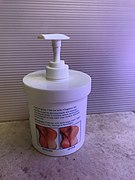Jar



A jar is a rigid, cylindrical or slightly conical container, typically made of glass, ceramic, or plastic, with a wide mouth or opening that can be closed with a lid, screw cap, lug cap, cork stopper, roll-on cap, crimp-on cap, press-on cap, plastic shrink, heat sealed lidding film, an inner seal, a tamper-evident band, or other suitable means. The English word "jar" originates from the Arabic word jarra, which means an earthen pot or vessel.[1][2]
Background
[edit]Jars can be used to hold solids too large to be removed from, or liquids too viscous to be poured through a bottle's neck; these may be foods, cosmetics, medications, or chemicals.[3] Glass jars—among which the most popular is the mason jar—can be used for storing and preserving items as diverse as jam, pickled gherkin, other pickles, marmalade, sun-dried tomatoes, olives, jalapeño peppers, chutneys, pickled eggs, honey, and many others.[citation needed]
Types
[edit]- Bell jar – typically used in scientific laboratories to produce a vacuum; also used in Victorian times for display purposes
- Cookie jar – typically ceramic or glass, common in the United States, Canada, and United Kingdom
- Killing jar – used to kill captured insects
- Leyden jar – a historical electrical capacitor
- Specimen jar – an instrument used in anatomy to preserve specimens
- Apothecary jar – historically for storage of medicines; made of ceramics or more typically in modern centuries, clear glass. Typically cylindrical or with rotationally symmetric decorative curves, sometimes with a glass disc foot separated from the main body. Modern glass versions are also used for artistic display of the contents.
- Modern glass food storage jars come in a variety of shapes, all of which have a circular opening on top for screwing on a lid
- [4]
- Economy round or wide mouth jars – tall but rotund cylinder slightly rounded at the top and bottom, relatively wide with a wide mouth, commonly used for sauces like a mayonnaise
- Paragon jars – tall and narrow cylinder, commonly used for pickled foods such as olives
- French square or Victorian jars – roughly a small cube
- Spice jars – small cylinder or rectangular cuboid
- Hexagon or hex jars – regular hexagonal prism
- Mason jars – moderately tall cylinder typically used in home canning, sealed with a metal lid
- Kilner jar – similar to a Mason jar but sealed with rubber
- Straight-sided jars – cylinders with no neck. Squat straight-sided jars are suitable for creams which can be scooped out.
- Ancient ceramic types include
- Amphora – large, but typically holding under 50 L
- Pithos – very large, typically the size of a person and holding hundreds of liters, Pandora's Box is often referred to as Pithos
- canopic jar
Utility
[edit]Jars are sterilised by putting them in a pressure cooker with boiling water or an oven for a number of minutes. Glass jars are considered microwavable.[5]
Some regions[where?] have a legally mandated deposit refundable upon return of the jar to its retailer, after which the jar is recycled according to the SPI recycling code for the material.[6]
Gallery
[edit]-
Preserved food in Mason jars
-
Reusable jam jar with flip-top or bail closure
-
Jar made of PLA-blend bio-flex, a bioplastic
-
Candy jar
-
Peanut butter
-
Six types of "earthenware jar" in Spain
-
Brown-glazed jar with design of three fish. Yuan Dynasty.
-
PP jar of skin cream with pump dispenser
See also
[edit]- Canning
- Home canning
- Child-resistant packaging
- Hu (vessel)
- Jar opener
- Tamper-evident
- Tamper resistant
- The asterism Water Jar in the constellation Aquarius
References
[edit]- ^ Abu-Haidar, J. A. (November 24, 2015). Hispano-Arabic Literature and the Early Provencal Lyrics. Routledge. p. 228. ISBN 978-1138976016.
- ^ Glevin, James E. (2016). The Modern Middle East: A History. Oxford University Press. p. 21. ISBN 978-0190218867.
- ^ Yam, K. L., "Encyclopedia of Packaging Technology", John Wiley & Sons, 2009, ISBN 978-0-470-08704-6
- ^ "Types of Packaging – Glass Bottles and Jars". Howtobuypackaging.com. April 4, 2019. Retrieved May 7, 2021.
- ^ Ahvenainen; Heiniö, R.-L. (1993). "Factors affecting the suitability of glass jars for heating in microwave ovens. Comparison with plastic jars and paper board tubs". Packaging Technology and Science. 6 (1): 43–52. doi:10.1002/pts.2770060108.
- ^ Soroka, W (2002). Fundamentals of Packaging Technology. ISBN 1-930268-25-4.
{{cite book}}:|work=ignored (help)
External links
[edit] Media related to Jars at Wikimedia Commons
Media related to Jars at Wikimedia Commons- . Encyclopædia Britannica. Vol. 15 (11th ed.). 1911.








